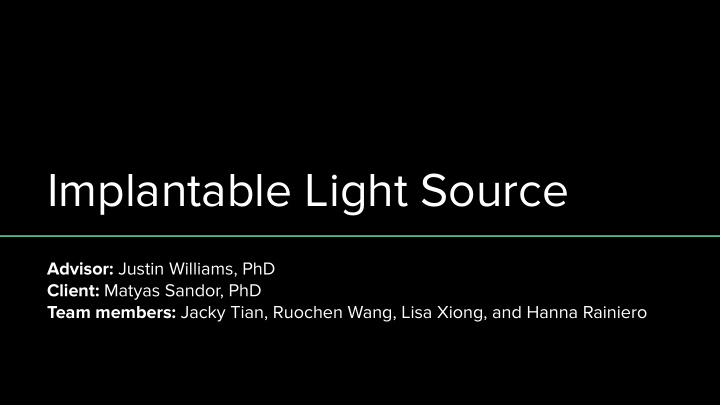



Implantable Light Source Advisor: Justin Williams, PhD Client: Matyas Sandor, PhD Team members: Jacky Tian, Ruochen Wang, Lisa Xiong, and Hanna Rainiero
The Team Jacky Tian Hanna Rainiero Lisa Xiong Richard Wang
Overview ● Background ● Problem Statement ● Product Design Specification ● Previous Prototype ● Previous Prototype Testing Results ● Circuit Schematic ● Electronic Circuit Design & Biomaterial Selection ● Future Work ● Acknowledgements ● References
Background Dr. Sandor and his team are investigating immune trafficking in mice infected ● with tuberculosis and multiple sclerosis to identify potential therapeutic targets ○ Photoconversion of cells to identify the rate of immune cell recruitment (405 nm) ○ Optogenetic activation of cells (480 nm) Fig 1. From Sandor’s Lab S Marcus
Problem Statement ● Current photoconversion methods are ineffective ○ Not all photoconversion sites can be found ○ Fiber optic light can only reach a small area of the lungs ● Needs a more efficient method that will photoconvert larger area (Fig. 2) Fig. 2: Red cells after the photoconversion shows that the cells responded to the infection
Product Design Specifications (PDS) ● Size Less than 1 cm 2 ○ ● Light Source ○ 405nm and 480nm Fig. 3: Example of lab mouse that would have the implant 95 mw/cm 2 for photoconversion ○ ● Safe Limited heat emission ○ ○ Biocompatible material User-friendly ○ ● Budget ○ We are trying to keep it under $25 per implant ○ Reusable (sterilizable with ethanol) Fig. 4: Our implant will emit at 405 nm and 480 nm
Previous Prototype Fig. 5, 6: The image to the left is the previously ● 4 LEDs connected in parallel developed Microcontroller for coding and power ● prototype. The image below is a supply CAD sketch of ● Disadvantages: the 4 LEDs and perf board in the ○ Too much wiring back Manufacturing is difficult ○ ○ Hard for maintenance
Previous Prototype Testing Results ● The LED mat design could reach a light intensity of over 800 Figure 7: Testing environment mW/cm2 with covered biomaterial, which shows it is capable of the light conversion. Figure 8: Spectrum of light emitted by LED
Circuit Schematic for New Prototype +5V LED Figure 8: proposed circuit schematic
Table 1: Design Matrix Electronic Circuit Design
Table 2: Design Matrix Biomaterials
Future Work ● Electric Circuit Design Biomaterial research ● ● Heat Diffusion testing ● Spectrophotometry testing ● In vivo testing by client’s lab members
Acknowledgement Our team would like to thank Dr. Williams for his guidance and thank Dr. Sandor’s Lab for providing us the opportunity to work on this project.
Sources ● http://www.fluorocarbon.co.uk/news-and-events/post/18/what-is-ultra-high-molecular-weight-polyethylene-uhmwpe ● https://www.azom.com/article.aspx?ArticleID=2630 ● Schmidt A., Westendorf C., Ridelis I. “Photoconversion.” Internet: https://www.leibniz-fmp.de/fileadmin/user_upload/Cellular%20Imaging/pdf/Photoconversion.pdf [Oct. 2, 2018] ● Turkowyd B., Balinovic A., Virant D., Carnero H., Caldana F., Endesfelder M., Bourgeois D. “Photoconversion of Green-to-Red Fluorescent Proteins Based on Blue and Infrared Light.” Internet: https://www.ncbi.nlm.nih.gov/pubmed/28574633 , 2017 [Oct. 3, 2018] ● Dr. Sandor and team
Questions?
Recommend
More recommend